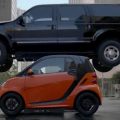The Year of Talking Cars
 The movies were right about the future of vehicle technology. The self-driving car is here and has been for quite a while.
The movies were right about the future of vehicle technology. The self-driving car is here and has been for quite a while.
Not only in the labs and the test tracks, but right here on the roads. The National Highway and Traffic Safety Administration released its proposal for Vehicle to Vehicle Communications in December of 2016.
This proposal (found here, if you like documents) outlined the rules, technology, and security precautions that the NHTSA would like to implement. Radio waves using certification processes would enable vehicles to calculate and communicate in ways that humans are not capable of. All of this with the explicit goal of avoiding collisions.
V2V tech intends to let cars communicate with each other to determine where the highest risks of crashes will be and notify the driver to avoid them. In some cases notifying the driver means stopping or changing the direction of the vehicle. This sort of technology is already being implemented in a few ways. The first is the individual vehicles that have driver assistance features.
The second way we see this technology is in the actual real-life self-driving cars that are on the road like it is totally normal. Tesla made a huge step for the automated car with some super-advanced autopilot. Uber did kind of the same thing with their version. Both of these are still heavily monitored and safeguarded by “drivers”, but it still really cool. Get a taste of the future-is-now right HERE.
Now, of course, this sounds like lawsuit city. We do take away the freedom of these decisions for the driver and give them to a robot that may make choices the human may not have made. In a future where we know no other way, that might work. But much like those that grew up without a seat belt law have a distaste for it now, there is a sour taste in the mouths of those that want to drive not ride. There are many moral and societal arguments against any kind of autonomous technology in cars. The Atlantic reported in length on the ethics of these self-driving cars. There’s also a beautiful little video from TED.
The safety of the driver is the priority, but can we admit that we’d like to sacrifice our human error for the statistic calculations of the car we drive? The industry and free-market seem to be making that choice for us.
Reasons to take Comedy Driving Defensive Driving
- Flexible Schedule
- Email Delivery Available
- Unlimited Log-ins
- State Approved
- No Final Exam
- Animated Course
- Free Audio and Video
- Comedic Course
- Live Phone Support
- No Hidden Fee’s








